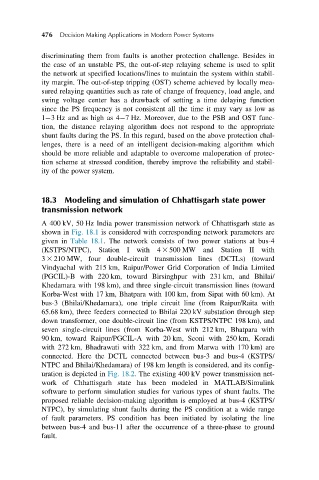Page 516 - Decision Making Applications in Modern Power Systems
P. 516
476 Decision Making Applications in Modern Power Systems
discriminating them from faults is another protection challenge. Besides in
the case of an unstable PS, the out-of-step relaying scheme is used to split
the network at specified locations/lines to maintain the system within stabil-
ity margin. The out-of-step tripping (OST) scheme achieved by locally mea-
sured relaying quantities such as rate of change of frequency, load angle, and
swing voltage center has a drawback of setting a time delaying function
since the PS frequency is not consistent all the time it may vary as low as
1 3 Hz and as high as 4 7 Hz. Moreover, due to the PSB and OST func-
tion, the distance relaying algorithm does not respond to the appropriate
shunt faults during the PS. In this regard, based on the above protection chal-
lenges, there is a need of an intelligent decision-making algorithm which
should be more reliable and adaptable to overcome maloperation of protec-
tion scheme at stressed condition, thereby improve the reliability and stabil-
ity of the power system.
18.3 Modeling and simulation of Chhattisgarh state power
transmission network
A 400 kV, 50 Hz India power transmission network of Chhattisgarh state as
shown in Fig. 18.1 is considered with corresponding network parameters are
given in Table 18.1. The network consists of two power stations at bus-4
(KSTPS/NTPC), Station I with 4 3 500 MW and Station II with
3 3 210 MW, four double-circuit transmission lines (DCTLs) (toward
Vindyachal with 215 km, Raipur/Power Grid Corporation of India Limited
(PGCIL)-B with 220 km, toward Birsinghpur with 231 km, and Bhilai/
Khedamara with 198 km), and three single-circuit transmission lines (toward
Korba-West with 17 km, Bhatpara with 100 km, from Sipat with 60 km). At
bus-3 (Bhilai/Khedamara), one triple circuit line (from Raipur/Raita with
65.68 km), three feeders connected to Bhilai 220 kV substation through step
down transformer, one double-circuit line (from KSTPS/NTPC 198 km), and
seven single-circuit lines (from Korba-West with 212 km, Bhatpara with
90 km, toward Raipur/PGCIL-A with 20 km, Seoni with 250 km, Koradi
with 272 km, Bhadrawati with 322 km, and from Marwa with 170 km) are
connected. Here the DCTL connected between bus-3 and bus-4 (KSTPS/
NTPC and Bhilai/Khedamara) of 198 km length is considered, and its config-
uration is depicted in Fig. 18.2. The existing 400 kV power transmission net-
work of Chhattisgarh state has been modeled in MATLAB/Simulink
software to perform simulation studies for various types of shunt faults. The
proposed reliable decision-making algorithm is employed at bus-4 (KSTPS/
NTPC), by simulating shunt faults during the PS condition at a wide range
of fault parameters. PS condition has been initiated by isolating the line
between bus-4 and bus-11 after the occurrence of a three-phase to ground
fault.

